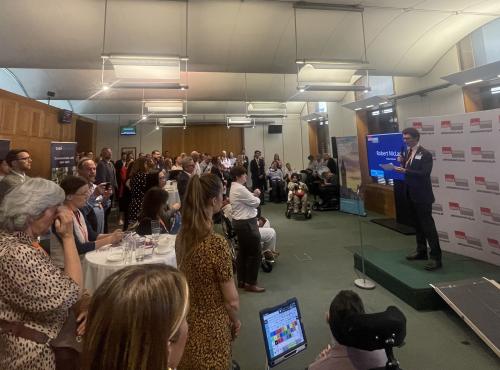Digital Accessibility in Higher and Further Education- the challenges and opportunities of 2020
For those of us working in the world of accessibility, 2020 has long been marked as the year when all public sector body websites and apps must adhere to updated Web Accessibility Regulations (September 23, 2020, to be exact). Now that 2020 is actually upon us, the world looks very different from what we imagined. The outbreak of COVID-19 has resulted in the rapid, forced digitisation of education, work, and even socialising. Meanwhile, Government Digital Service, the department responsible for monitoring compliance with the regulations, has made clear there will be no delay to the 23 September deadline. To mark Global Accessibility Awareness Day 2020, we reflect on the challenges and opportunities for digital accessibility in further and higher education presented by this landmark year.
In 2018, Policy Connect and the APPG for Assistive Technology published our report on Accessible Virtual Learning Environments in which we analysed the specific challenges of implementing the public sector regulations in FE and HE and made recommendations to government and educational institutions. Since then, we have seen a huge increase in awareness of the topic within the sector but have witnessed significant variation in how well institutions are preparing for the September 2020 deadline. One trend that has emerged is that those organisations with senior leaders who have a clear inclusion vision have been able to do more, and more effective, work on improving their digital accessibility. Ben Watson, a leader in the field of digital inclusion in HE, explains,
“We feel we are on a good trajectory at the University of Kent thanks to highly supportive senior leadership. This has led to wide engagement and embedding of core inclusive technologies, and strategies at the beginning of processes so that they are woven into their ongoing development. Digital accessibility is the responsibility of everyone and this is being embraced as a core value that enhances the universal user experience- all the more so when it is built in from the start.”
Many disabled students, however, have been struggling with digital and physical accessibility. During an evidence session last November for Policy Connect’s Higher Education Commission on the experiences of disabled students, one student recounted how, “there has not been a single document accessible to me. Lectures have been inaccessible, the activities that we’ve done in seminars have been inaccessible, and rooms have been inaccessible.” Since the lockdown, universities and colleges have had to rapidly transition to remote teaching and learning. While this may mean fewer physical accessibility challenges, digital accessibility is more important than ever. Within the HE sector specifically, this turn of events has been both positive and challenging. Dr Abi James of AbilityNet reflects how,
“COVID has made apparent just how important online learning is. In some organisations it has helped push the digital accessibility agenda and highlighted where the issues are. On the other hand, COVID has been a barrier to preparing for the new regulations in some places because people who would have been working on accessibility are now being pulled to help get everything online.”
In the short term, disabled students seem to be struggling as a direct result of the changes. According to a recent survey by the Association of Non-Medical Help Providers, 81.3% of 3,614 respondents in receipt of the Disabled Students’ Allowance (DSA) said that they agree or strongly agree with the statement “because of changes to my academic work, online teaching, and assessments, the COVID-19 situation is negatively impacting my studies.” The top 3 factors students reported as negatively impacting their studies are all issues of digital accessibility: access to academic resources, access to teaching, and access to course materials. On a somewhat more positive note, 55% of students agreed or strongly agreed that, “remote online DSA support is effective for me.”
Compared to universities, colleges are further behind in their digital accessibility journeys. One of the requirements of the regulations is the publication of accessibility statements which must detail any inaccessible parts of a website or app and how people can request alternatives to inaccessible content. Recent research by George Rhodes (co-founder of AllAble along with Ben Watson) has found that 30.8% of universities currently have compliant accessibility statements on their websites compared to 2.9% of colleges. Because there are so many college websites with poor or no statements, George suspects that low awareness of the regulations amongst the FE sector is one reason behind the discrepancy. Organisations such as Jisc and AbilityNet are working hard to raise awareness and provide accessibility training to the sector.
City College Norwich, one of the Education & Training Foundation’s National Centres of Excellence for SEND, is among the few FE institutions that currently has a compliant accessibility statement. Principal Corrienne Peasgood OBE reflects on how, “support for students with accessibility requirements is a key strength of the college’s provision and, crucially, inclusive values are firmly embedded throughout our curriculum areas and support departments. Staff were therefore quick to take on board the importance of the Accessibility Directive. Our Senior Learning Technologist, utilising Blackboard Ally, and marketing team collaborated to swiftly implement the Directive for both our Virtual Learning Environment and website.” Of course, digital accessibility does not just benefit disabled students - the vast majority of alternative formats downloaded via Blackboard Ally are done so by students without a declared disability. Between February and March there has been a 100% increase in the use of alternative formats in Ally, which reflects the appetite for inclusive digital resources as a result of the ongoing lockdown.
Communities of passionate digital accessibility advocates have also stepped up to volunteer their time and resources in an effort to support struggling institutions. For example, members of the FE/HE Digital Accessibility Working Group, with generous support from textBox, have created searchBox - a free database of 3rd party accessibility statements which covers platforms from VLEs to finance to publishers. However, strong leadership is needed to empower staff to engage with these tools and wider sector initiatives to drive change in their institutions.
The shift to remote learning means that digital accessibility is more essential than ever, and 2020 is a year full of opportunities to build in accessibility as part of the general shift to remote teaching and learning. Now is the time to embrace our duty as a country to ensure every student has the opportunity to succeed in their education.



